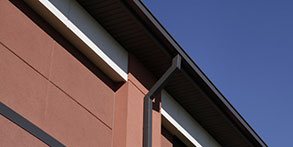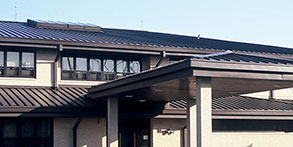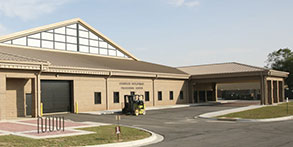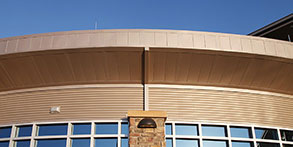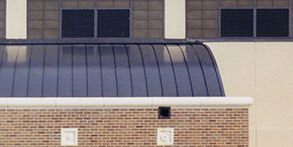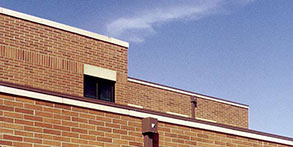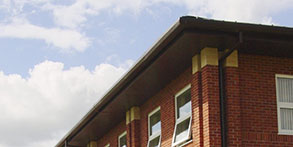- Gutters are recommended for all eaves receiving water. They are required for all eaves above the first story unless the area drained is minimal.
- All gutters and fascias will normally match the roof color. At facilities where the color of the roof and fascia differ, the gutter may match the color of the fascia.
- Size the roof drainage system for 10-year storms per SMACNA.
- Integrate downspouts with the architectural details of the wall system and arrange in an orderly, non-prominent appearance.
- Follow base standards for color, generally blending downspouts with the color of the wall (not contrasting it).
- Fabricate downspouts from non-corrosive materials such as aluminum, zinc-coated steel, or stainless steel per base standards. Stainless steel may only be used with base-level Architectural Review Board (ARB) approval.
- Open-faced downspouts may be used in severe climates.
- Use scuppers when required in parapet walls. Arrange scuppers in an orderly manner consistent with other elements of the wall system.
- Preference is to avoid the use of open scuppers. Unless they are the backup for an internal drain system, they should terminate in downspout heads.
- Angled transitional pieces will be provided for downspouts so they fit closely against the wall for their entire length.
- Coordinate locations of control joints in masonry and stucco walls with downspouts when possible.
- Place downspouts away from building entries. Water discharged should not run across sidewalks.
Design and construct roof systems to shed water and shade walls and openings. Use their reflectance to reduce heat transfer. Select roof materials that will not show excessive weathering or wear during their typical life span.
Roof color, material and form are prominent features and play a significant role in architectural compatibility. Ensure visible roof systems are comparable in shape, slope, material and color on an installation and follow Installation Facilities Standards (IFS) and requirements for the Facility Group.
Coordinate and integrate roof and wall systems to ensure that individual elements have an uncluttered, organized appearance. Avoid overly complicated solutions and combination of multiple styles, forms and types on a facility.
Sustainability
Roofing systems must contribute to the mitigation of heat island effect and provide a Solar Reflectance Index (SRI) as outlined in these standards. When life cycle cost effective and allowed by law, design roof systems with full integration of rainwater collection, non-potable irrigation and stormwater systems.
Following the directives of UFC 1-200-02, evaluate the life-cycle cost effectiveness of “passive” building components that provide shading, such as roof overhangs and fixed shading grilles, meshes and screens.
Resilience
Provide engineered designs in response to documented risks associated with high winds, hurricanes and typhoons for all roof materials and detailing. Consider the design of overhangs and roof features such as clerestories, dormers and parapets when selecting roof materials and detailing roof systems.
UFC 1-200-01 General Building Requirements https://www.wbdg.org/ffc/dod/unified-facilities-criteria-ufc/ufc-1-200-01
UFC 1-200-02 High Performance and Sustainable Building Requirements https://www.wbdg.org/ffc/dod/unified-facilities-criteria-ufc/ufc-1-200-02
UFC 3-101-01 Architecture https://www.wbdg.org/ffc/dod/unified-facilities-criteria-ufc/ufc-3-101-01
UFC 3-110-03 Roofing https://www.wbdg.org/ffc/dod/unified-facilities-criteria-ufc/ufc-3-110-03
UFC 3-110-04 Roofing Maintenance and Repair https://www.wbdg.org/ffc/dod/unified-facilities-criteria-ufc/ufc-3-110-04
UFC 3-210-10 Low Impact Development https://www.wbdg.org/ffc/dod/unified-facilities-criteria-ufc/ufc-3-210-10
UFC 3-575-01 Lightning and Static Electricity Protection Systems https://www.wbdg.org/ffc/dod/unified-facilities-criteria-ufc/ufc-3-575-01
UFC 4-010-01 DoD Minimum Antiterrorism Standards for Buildings https://www.wbdg.org/ffc/dod/unified-facilities-criteria-ufc/ufc-4-010-01
AFI 32-1051 Roof Systems Management https://static.e-publishing.af.mil/production/1/af_a4/publication/afi32-1051/afi32-1051.pdf
ETL 08-10 Alternative Water Sources – Use of Non-Potable Water https://www.wbdg.org/FFC/AF/AFETL/etl_08_10.pdf

